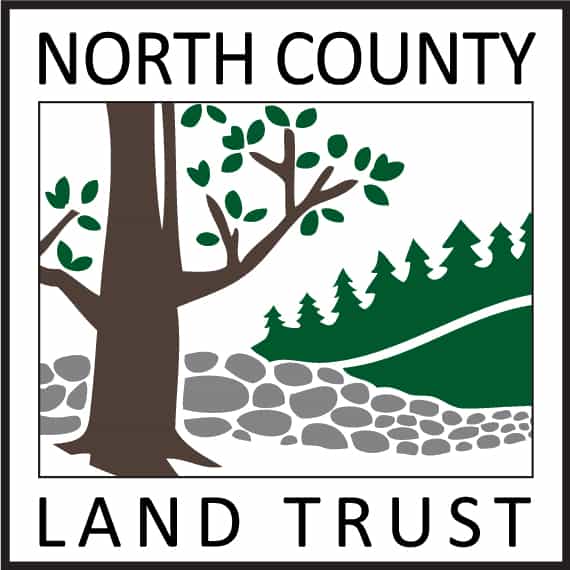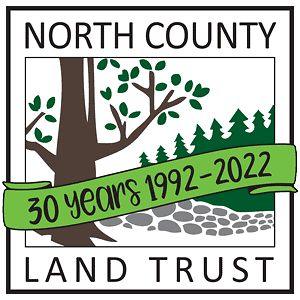 On May 28th, 2020 North County Land Trust hosted a Natural History’s Influence on Habitat Management Today webinar on the Zoom platform. The presenter was habitat biologist, Pat Conlin, who covered natural history of Massachusetts from the end of our most recent ice age to today and how these influences affect our wildlife through population trends and forest composition. Pat also looked at opportunities that exist to land owners and managers to address declining wildlife through habitat management programs.
On May 28th, 2020 North County Land Trust hosted a Natural History’s Influence on Habitat Management Today webinar on the Zoom platform. The presenter was habitat biologist, Pat Conlin, who covered natural history of Massachusetts from the end of our most recent ice age to today and how these influences affect our wildlife through population trends and forest composition. Pat also looked at opportunities that exist to land owners and managers to address declining wildlife through habitat management programs.
If you were unable to attend or would like to watch the webinar again, please see the recording HERE.
Presenter
Pat Conlin is a private lands habitat biologist at the Massachusetts Division of Fisheries and Wildlife. He offers technical assistance to landowners across the state who wish to manage their lands for the benefit of wildlife and biodiversity. Previous to his state position, he practiced as a consulting forester for Bay State Forestry where he planned and administered forest management throughout Massachusetts, Connecticut, and southern Vermont. In addition he worked as an arborist for various private tree care companies in Rhode Island and Massachusetts. Pat holds degrees in Forest Technology from the University of New Hampshire and Forest Health from the University of Massachusetts. In his spare time he volunteers for the Vermont Center for Ecostudies as a participant in Mountain Birdwatch and tends to his small woodlot in Buckland, MA with his wife, daughter, and two dogs.
Resource Material
Pat’s Presentation – Habitat Management and Land-Use History in Massachusetts PDF of slides.
Habitat Resources
The Young Forest Project – Partners working to create young forests in the Northeast, working to demonstrate the importance of wildlife habitat.
Mass Audubon Breeding Bird Atlas – A Breeding Bird Atlas (BBA) is a collection of data about all of the birds that breed in a particular state or region.
Old-Growth Is Great, But Here’s Why We Need New-Growth Forests, Too – Article from the Spring 2018 issue of Living Bird magazine.
Options for managing early-successional forest and shrubland bird habitats in the northeastern United States – Article from US Forest Service discussing importance of regenerating forest habitat and historically disturbed habitats.
Productivity of Early Successional Shrubland Birds in Clearcuts and Groupcuts in an Eastern Deciduous Forest – Article from US Forest Service looking at mature forest and early successional forest habitat for bird habitat.
Do mature forest birds prefer early-successional habitat during the post-fledging period? – Article from US Forest Service investigating habitat use by forest-nesting birds during the post-fledging period.
Fuels Management and Habitat Restoration Activities Benefit Eastern Hognose Snakes (Heterodon platirhinos) in a Disturbance-Dependent Ecosystem – Article from the Journal of Herpetology looking at Eastern Hognose Snakes, a species of conservation concern, due to their association with rare and declining habitats which are disturbance-dependent.
Trees, Shrubs, and Vines for Attracting Birds – Guidebook by Richard M. DeGraff (Second Edition)
New England wildlife: habitat, natural history, and distribution – Article from US Forest Service describing natural history profiles of New England wildlife species and their associations with forested and nonforested habitats.
Options for managing early-successional forest and shrubland bird habitats in the northeastern United States – Article from Forest Ecology and Management.
Conservation of disturbance-dependent birds in eastern North America – Article from Wildlife Society Bulletin.
Importance of Early Successional Habitats to Mammals in Eastern Forests – Article from The Wildlife Society.
State Wildlife Action Plan (SWAP) – This Plan presents the 570 Species of Greatest Conservation Need in the Commonwealth, the 24 types of habitat that support these species, and the actions necessary to conserve them.
Can regenerating clearcuts benefit mature-forest songbirds? An examination of post-breeding ecology – Article from Biological Conservation.
Land Use Resources
Landscape History of Central New England – Seven of the Harvard Forest dioramas form a historical series that depicts changes in the New England landscape over the past 300 years at one location.
Time series analysis of satellite data reveals continuous deforestation of New England since the 1980s – Article from Environmental Research Letters.
State Resources
MassWildlife can help landowners create young forests – Get technical and financial assistance to create young forest on your property.
MassWildlife’s Habitat Programs – Habitat Programs conserve rare and declining wildlife through restoration and management of grassland, shrubland, and young forest habitats.
Mass.gov Service Forestry – Service Forestry, also referred to as Private Lands Forestry, provides technical assistance and services to landowners and municipalities.
Carbon Resources
Forecasts of Climate-Associated Shifts in Tree Species (ForeCASTS) – From the Climate Change Resource Center.
Carbon Info Page – From US Forest Service
Forest Service Debuts State-by-State Statistics on Carbon as Part of National Greenhouse Gas Reporting – US Forest Service News
Carbon storage on MassWildlife lands – Land protection and management practices provide big gains for both wildlife and climate.
Massachusetts Wildlife Volume 69 Issue 4 – Features an article Carbon And Conservation On MassWildlife Forest Lands
Forest Carbon – Forest Carbon: An essential natural solution to climate change, a booklet put out by MassWoods at UMass Amherst.
Funding Sources
MassWildlife Habitat Management Grant Program (MHMGP) – The MassWildlife Habitat Management Grant Program provides assistance to private and municipal owners of protected lands to enhance wildlife habitat, while promoting public access for outdoor recreation.
Environmental Quality Incentives Program (EQIP) – How to apply guide from the Natural Resources Conservation Service Massachusetts
Community Forest Stewardship Implementation Grant – The Massachusetts Forest Stewardship Program is now offering Community Forest Stewardship Implementation Grants. These are 50-50 matching reimbursement grants offered to municipalities that have town forest, conservation or water supply land currently enrolled in the Massachusetts Forest Stewardship Program.
Foresters for the Birds: Assessing Your Woods for Bird Habitat – The DCR Bird Habitat Assessment Program, in partnership with MassAudubon, provides funding assistance to landowners to work with a consulting forester or other qualified professional to evaluate existing and potential habitat for a selection of birds.
